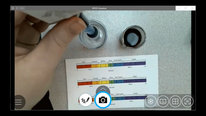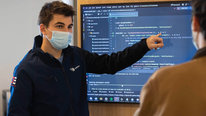- Haley Harville-York
- Graduate Research Assistant, NSF LIST Scholarship Program Coordinator
- Presenter’s NSFRESOURCECENTERS
- University of Alabama
- Cynthia Sunal
- Department Head
- Presenter’s NSFRESOURCECENTERS
- University of Alabama
- Dennis Sunal
- Professor, Science Education
- Presenter’s NSFRESOURCECENTERS
- University of Alabama
- Rachael Tawbush
- Graduate Teaching Assistant & NSF NOYCE LIST Scholarship Program Coordinator
- Presenter’s NSFRESOURCECENTERS
- University of Alabama
LIST
NSF Awards: 1660557
2019 (see original presentation & discussion)
Undergraduate, Graduate
The Developing Leaders in Science Teaching (LIST) program's purpose is to provide STEM graduates/professionals in biology, chemistry or physics with secondary science certification. Pre-service teachers complete a strong, clinically-based program with an emphasis on developing their skills in engaging diverse students. An additional goal of the program is moving its teachers from mentored novices to teacher leaders in the education community through long term mentoring via PLCs.
Science
Univ of Alabama
Robert Noyce Teacher Scholarship Program (NOYCE)
Related Content for Developing Leaders in Science Teaching
-
 2020Developing Teacher Leaders with Professional Collaboration
2020Developing Teacher Leaders with Professional Collaboration
Sabrina Stanley
-
 2021Virtual Science Teaching Strategies in Response to Pandemic
2021Virtual Science Teaching Strategies in Response to Pandemic
Sabrina Stanley
-
 2021Noyce Capacity Building Project at Bellarmine University
2021Noyce Capacity Building Project at Bellarmine University
Kristin Cook
-
 2021Near peer mentoring for mathematics and science teachers
2021Near peer mentoring for mathematics and science teachers
Janelle Johnson
-
 2019STEM Teaching through Community
2019STEM Teaching through Community
John Pecore
-
 2020Making Sense of Place: CSU NSF Noyce Program
2020Making Sense of Place: CSU NSF Noyce Program
Meena Balgopal
-
 2020Supporting PBL Instruction on the US-Mexico Border
2020Supporting PBL Instruction on the US-Mexico Border
Amy Wagler
-
 2021Using Bridging Practices to Support New STEM Teachers
2021Using Bridging Practices to Support New STEM Teachers
Bo Idsardi
This video has had approximately 240 visits by 195 visitors from 78 unique locations. It has been played 100 times as of 05/2023.
Map reflects activity with this presentation from the 2019 STEM for All Video Showcase: Innovations in STEM Education website, as well as the STEM For All Multiplex website. 
Based on periodically updated Google Analytics data. This is intended to show usage trends but may not capture all activity from every visitor.
show more
Discussion from the 2019 STEM for All Video Showcase (9 posts)




Haley Harville-York
Graduate Research Assistant, NSF LIST Scholarship Program Coordinator
Welcome and thank you for watching our video!
This video outlines the experiences of our first cohort of pre-service teachers during their accelerated one-year master's degree program. We look forward to reading your comments and answering your questions.
Kristen Reed
Senior Project Director
Hi Haley, LIST looks like a great program for training new science teachers. I was wondering what some of your biggest challenges have been working with this first cohort and what changes you are thinking of making for the next cohort of students. Thanks! Kristen
Rachael Tawbush
Graduate Teaching Assistant & NSF NOYCE LIST Scholarship Program Coordinator
Hey Kristen,
One of the biggest challenges we face in this program is recruitment. Although this program provides scholars with a substantial scholarship, teacher certification, and a master's degree within one year, we are still struggling to find students who want to enter the field of education. The concern of teacher shortage, especially in STEM fields, is widespread throughout the country. We are hoping with incentives, such as financial support and ongoing professional development (ex. 5 -year professional learning communities), we can help address this shortage. We also want to ensure the teachers graduating out of our program are highly qualified teachers and teacher leaders, which is also meant to assist with STEM teacher retention. The preservice teachers (PSTs) in Cohort one are absolutely phenomenal and we are looking forward to Cohort two. As the LIST scholarship continues, we as researchers and educators are constantly reflecting on how we can improve the program. We also implement ongoing measurement tools throughout our study, and in combination with the scholars' reflections, we make changes accordingly to the program as needed. One great example of a change we made this year was based upon our PSTs reflections. Our PSTs asked the committee if we could take field trips around the state of Alabama to assist them in making field trip decisions for their future classrooms. By listening to our PSTs and providing feedback in real time, we were able to coordinate field trips in Alabama, some of which are seen in the video clip. The field trips were found to be very productive in assisting our students develop as professional educators. The field trips not only opened our scholars' eyes to possible field trips available in our state for their future students, they also allowed them to make connections throughout the state and gain access to a plethora of instructional materials for their classrooms. Thank you so much for watching our video and for your insightful questions.
Best Regards,
Rachael Tawbush
Rachel Garrett
Senior Researcher
I really appreciated how you showcased the voices of your PSTs in your video! I would love to hear more about how your model works for supporting PLCs over multiple years. Do the people involved in the PLC change over time? How does this evolve as PSTs transition into teachers of record? Also, is there a common format and/or focus you use for PLCs in your program, or are they more open-ended/driven by the PLC participants?
Haley Harville-York
Graduate Research Assistant, NSF LIST Scholarship Program Coordinator
Thanks Rachel! Each PLC during internship was made up of one pre-service teacher, one cooperating teacher, one science education specialist, and one content area specialist. Since these were alternative certification master's students, each had a bachelor's in either physics, biology, or chemistry. They were placed in a classroom teaching that subject, and their content specialist was a current professor at UA in that field.
The members of the PLC will change over time to fit the scholar's needs. For example, each student is certified in general science and may not be teaching the same subject next year. Also, many already have jobs lined up next year, but none are local. So, we hope to create new PLCs based on their new jobs, alter the content specialist accordingly, and meet virtually.
Cynthia Callard
Executive Director/Professor
This sounds like a really interesting project! Thank you for sharing. I look forward to hearing what happens next as you work to support your scholars in the field with PLCs. I appreciate the make-up of the PLCs during internship with a variety of areas of expertise. I am wondering how you will support these scholars logistically (and have the capacity yourselves) as they start new jobs since it sounds like they may be spread out geographically. I am also curious about the emphasis you noted on developing scholars' "skills in engaging diverse students." Can you say more about what you mean by this and how you did it? Thanks!
Haley Harville-York
Graduate Research Assistant, NSF LIST Scholarship Program Coordinator
Thank you for your comments! Cohort 1 will begin an online induction program late July of this year which will help them prepare for their first day/week/year as an in-service teacher. Many scholars expressed concerns in their PLC meetings about beginning a school year alone, and we are using their feedback to shape the course. The induction course will continue throughout the semester and require the students to share strategies they have used on a discussion board as well as reflect on how well these strategies worked. Topics will include classroom management, lesson planning, data-driven instruction, etc. This induction course will be in addition to the PLC teams. Teams will meet a minimum of once a month through a virtual format such as zoom. The (now) in-service teacher will determine topics he or she has questions or concerns about at each meeting.
Our program requires one semester of 110 hours of field work, and one semester of full-time internship, over 450 hours, in the classroom. To ensure each scholar had opportunities to engage diverse students, we purposely placed them at a middle school for field work and a high school for their internship. We also made sure one placement was in a city school, while the other was in a county school. In addition, all high school placements included at least two different content areas. All schools were high needs. At the end of the year, scholars had an idea of which age level and subject they preferred teaching. We even had some students apply for jobs at the high school where they completed their internships.
Joanna Werner-Fraczek
Very interesting project on how to bring more science into our teacher's mind. I know many great educators that are afraid of bringing research-based learning into their curriculum. I hope what you learned can be propagated as an example of what can be adopted in a classroom for many disciplines.
Great job.
Dennis Sunal
Professor, Science Education
The LIST program research is just beginning and data is being collected. To date, qualitative data supports positive changes in the pre-service teacher's approach to establishing a more student centered classroom. Data also indicates that a more supportive environment exists for the pre-service teachers during their teacher preparation program than for tradition program students. The LIST program goal is towards development of science teacher leaders in their schools and school systems. Additional intensive research/evaluation is ongoing.
Further posting is closed as the event has ended.